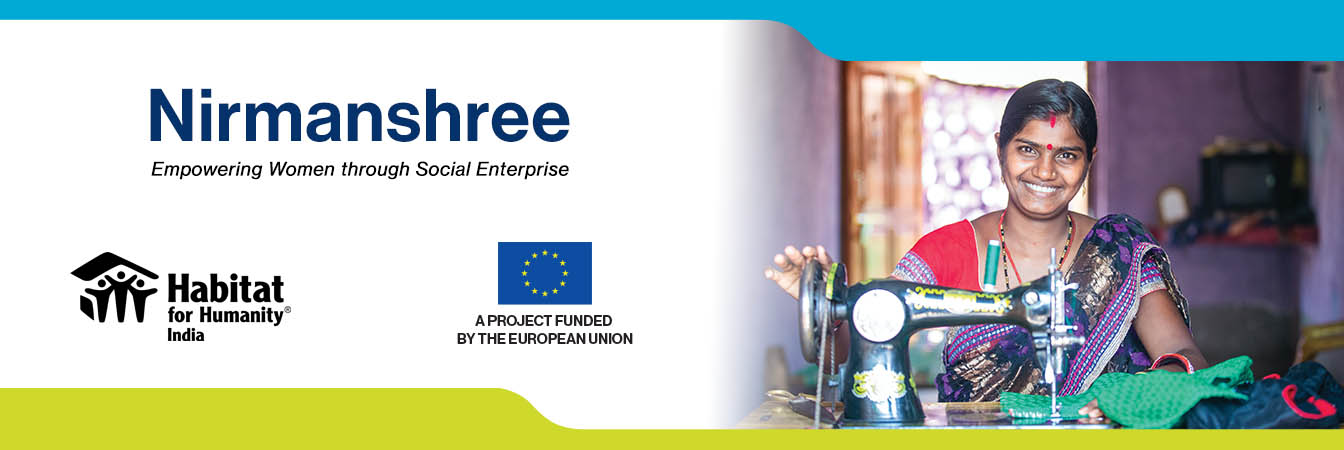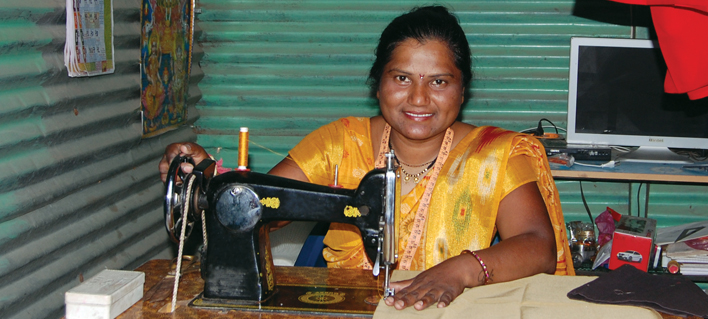1. How will Nirmanshree impact women?
Nirmanshree will address gender inequalities that exist in India’s housing sector, such as barriers to owning land, insufficient engagement in decision-making, low wages, lack of skills, and limited training opportunities that prevent women from improving their capacities to ensure decent livelihoods in new market conditions. The project will create economic opportunities around habitat development, i.e., the housing ecosystem consisting of housing, energy, water and sanitation, energy and livelihood. It will improve access to services and entitlements related to housing, including drinking water, sanitation and energy. Through this project, 3,000 poor and marginalized women and girls will have access to technical and entrepreneurial skills, strengthening their core capabilities to help them demand social entitlements and basic services related to housing.
The project will contribute to the following SDGs:
SDG 1 (Poverty reduction by income enhancing by facilitating decent employment for women in the housing sector); SDG 3 (Good Health & Wellbeing - Ensure healthy lives and promote wellbeing for women by promoting climate- climate resilient); SDG 8 (Decent Work & Economic Growth - Promote inclusive and sustainable economic growth and employment for women); SDG9 (Industry, Innovation & Infrastructure - Build climate-resilient infrastructure, promote sustainable consumption and foster innovation); SDG 11 (Sustainable Cities & Communities - Make cities inclusive, safe, resilient and sustainable by providing sustainable housing solutions to women in cities); SDG 12 (Responsible Consumption & Production - By promoting resource and energy efficiency in housing sector, sustainable and green infrastructure, and providing access to housing support services and green jobs) and SDG 13 (Climate Action - Developing climate-resilient housing solutions to combat climate change and its impacts).
2. What are the expected short-term and long-term impact of the project?
In the short term, Nirmanshree will address the growing demand for skilled workers in the housing sector by building the capacity of existing women’s federations and developing women’s skills for housing solutions and entrepreneurship development.
In the long term, Nirmanshree as a social enterprise will be established to strengthen the voice of women and related agencies for undertaking policy dialogue with decision-makers to enhance women's participation in habitat-related interventions. Women and girls that were part of the project would be able to participate at the local level in planning, designing and implementation of service delivery (habitat development) for poor families with particular emphasis on vulnerable women.
3. Who are the target audience (beneficiaries) and on what criteria will they be selected?
Nirmanshree aims to work with women entrepreneurs from selected women’s federations, particularly single women, girls, widows, and women living with HIV/AIDS.
4. In which districts will the project be operational?
Habitat for Humanity India will implement Nirmanshree in Dhenkanal and Jajpur in Odisha, and in Osmanabad and Beed in Maharashtra.
5. What is Nirmanshree’s project timeline?
Habitat for Humanity India will implement Nirmanshree for three years, from January 2020 to December 2022.
6. Would Habitat for Humanity continue its involvement with the communities after the end of the project?
Yes, Habitat for Humanity will continue its involvement with the project through the establishment of the social enterprise, Nirmanshree. Habitat India will continue using the services/products developed and produced by Nirmanshree in some of its housing projects. Habitat India will recommend the same to its partners.
7. What are the expected communication material and publications to be developed with EU emblem with the project logo?
Training material /modules
USB lanyards with the presentation for the project staff and trainers
Banner/stand-up banners for the training and other events
IEC Material-posters, leaflets / large signs at project sites and community events
Eco Friendly /re-usable training bags/kits with logo
Project Video and small promotional video clips for campaign
Press release and media kits during events
Webinars
8. How will the Nirmanshree Project contribute to the specific SDGs and EU Result Framework (EURF)?
The project Nirmanshree is proposed to impact sustainable development goals such as
SDG 1 :Poverty reduction by income enhancing through facilitating decent employment for women in housing sector.
SDG 3 : Good Health & Well Being – Ensure healthy lives and promote wellbeing for women by promoting climate-resilient solutions.
SDG 8 : Decent Work and Economic Growth.
SDG 9 : Industry, Innovation and Infrastructure - Build climate resilient infrastructure, promote sustainable consumption and foster innovation.
SDG 11 : Sustainable Cities and Communities - Make cities inclusive, safe, resilient and sustainable by providing sustainable housing solutions to women in cities.
SDG 12 :Responsible consumption and production – By promoting energy efficient resources, developing sustainable and green infrastructure, providing access to Housing Support Services (HSS) and green jobs.
SDG 13 : Climate Action – Developing climate resilient housing solutions to combat climate change and its impacts) and
SDG 16 : Peace, justice and strong institutions.
The EURF (European Union Result Framework) was adopted in the project to measure the impact and its contribution towards the goals. The EURF indicators for the project basically focuses on employability of women in the housing and housing allied sectors including WASH and Energy sector, Improved economic governance, promote resource efficiency, production of eco-friendly housing materials and advocacy for inclusive policy for women.




